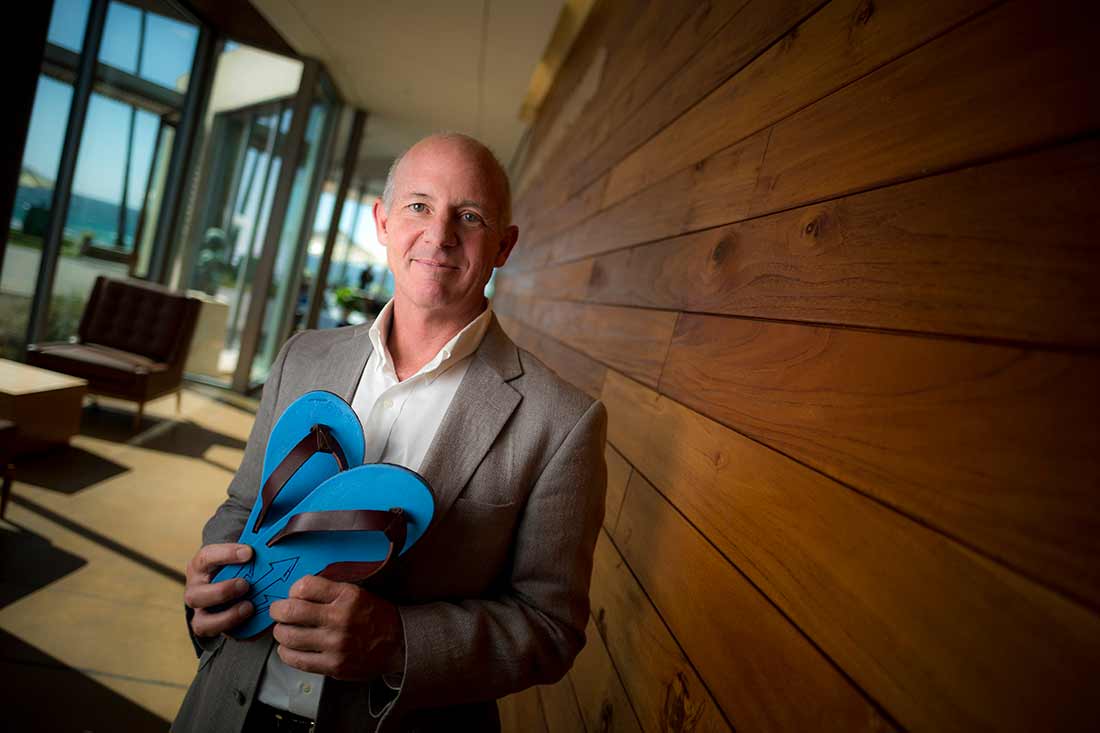
San Diego startup is using algae feedstock to sustainably reinvent the world’s most popular footwear — the humble Flip-Flop.
The most popular footwear in China, India and Africa just got a green and sustainable facelift
Students and researchers at University College San Diego have produced the world’s first algae-based, renewable flip flops, with the potential to remove petroleum-based feedstock from the manufacture of 3 billion shoes worldwide every year.
3 billion petroleum-based flip flops are produced worldwide each year
University College San Diego students and researchers have produced the world’s first algae-based, renewable flip flops. The first prototypes of their new invention, developed over the summer in a York Hall chemistry laboratory, consist of a flexible, spongy slipper adorned with a Triton logo and a simple strap—fairly basic, as flip flops go.
But when they go into full production later this academic year at what researchers hope will be a projected cost of $3 a pair, the impact of this campus innovation could be revolutionary, changing the world for the better environmentally.
That’s because 3 billion petroleum-based flip flops are produced worldwide each year, eventually ending up as non-biodegradable trash in landfills, rivers and oceans around the globe.
“Even though a flip flop seems like a minor product, a throwaway that everyone wears, it turns out that this is the No. 1 shoe in the world,” says Stephen Mayfield, a UC San Diego professor of biology who headed the research effort with Skip Pomeroy, a professor of chemistry and biochemistry.
“These are the shoes of a fisherman and a farmer. This is the No. 1 shoe in India, the No. 1 shoe in China and the No. 1 shoe in Africa. And, in fact, one of the largest pollutants in the ocean is polyurethane from flip flops and other shoes that have been washed or thrown into rivers and flow into the ocean.”
Mayfield and Pomeroy, along with their undergraduate and graduate students, teamed up two years ago to develop the world’s first algae-based surfboard. The UC San Diego scientists worked with a local surfboard blank manufacturer, Arctic Foam of Oceanside, to figure out how to make from algae oil the hard, polyurethane foam core of a surfboard, which is typically constructed from petroleum.
That development, which was quickly embraced by a surfing industry looking for ways to produce more sustainable and environmentally friendly products, got the two UC San Diego professors thinking about their next step.
If this could be done for some of the 500,000 surfboards annually sold around the world, why not for the 3 billion flip flops and millions of other new shoes that each year clutter our landfills and oceans?
Source: ucsdnews.ucsd.edu

“When you look at the numbers you realize that making a flip flop… is much more important,”
“The algae surfboard was the first obvious product to make, but when you really look at the numbers you realize that making a flip flop or shoe sole like this is much more important,” says Mayfield. “Depending on how you do the chemistry, you can make hard foams or soft foams from algae oil. You can make algae-based, renewable surfboards, flip flops, polyurethane athletic shoes, car seats or even tires for your car.”
“In the laboratory, students are far more engaged when they’re actually trying to solve a problem,” says Skip Pomeroy, on the University College newsletter website.
To demonstrate the feasibility of their campus-based innovation, Triton Soles, Mayfield and Pomeroy applied for and were awarded last April a $50,000 proof-of-concept grant from the campus Office of Research Affairs. Theirs was one of eight grant awards made in the first year of the Accelerating Innovations to Market program, initiated by UC San Diego’s Office of Innovation and Commercialization, a part of the Office of Research Affairs, and paid for with the help of local elected officials through State Assembly Bill 2664.
The goal of the bill is to bring more laboratory inventions from the campus to commercial development.
“Part of the challenge is that typically I’d make a discovery, publish a paper and that’s sort of the end of it,” Mayfield explains. “But the best invention that you keep inside the lab really isn’t valuable for the world. And the way you make that invention valuable is to turn it into a product.”
The two professors, along with Michael Burkart, a professor of chemistry and biochemistry, formed a startup company, Algenesis Materials, which employs some of the students working on the flip flops and other projects and provides them with the opportunity to experience what Pomeroy calls “project-based learning.”
“Teaching chemistry in the classroom is sometimes like trying to teach soccer at the chalkboard,” Pomeroy explains. “In the laboratory, students are far more engaged when they’re actually trying to solve a problem. Most people will tell you that our students are really, really bright, but they don’t always have practical experience. This is a way to provide them with that.”
Source: ucsdnews.ucsd.edu

10 Shoe Brands That Contribute to Environmental Causes
We all do our best to recycle — but can we protect the environment through the shoes we wear? The answer is yes. A variety of footwear brands are using fashion for good, utilising sustainable manufacturing processes and contributing to various environmental causes. Click to see 10 of our favourite eco-friendly labels.